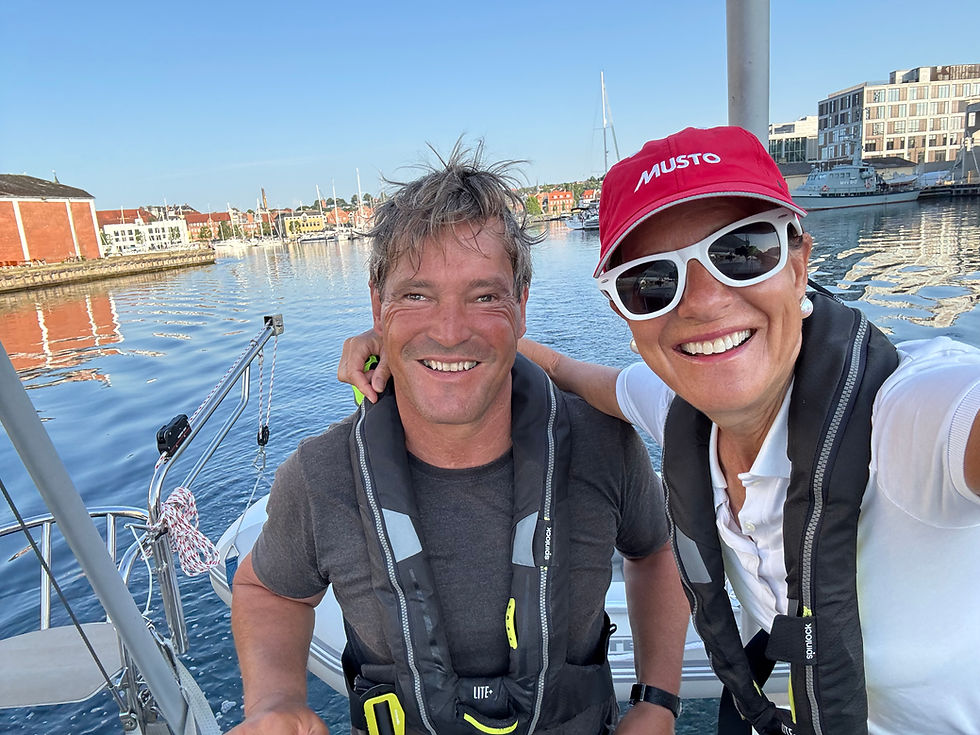Island of Texel, Netherlands
- Beth Solomon

- Jul 3, 2024
- 4 min read
Updated: Jul 29, 2024

Texel looked like a ghost town by the time we returned from a few landlubbing days in Haarlem and Hilden. On this quaint island with as many sheep as people, three quarters of the sailboats were missing, and the skies had turned ominous. Even the friendly “baa, baa” went quiet at the marina.

“Where did all the yachts go?” we asked Willem, the harbor master.
“Ah, day went back to the IJsselmeer,” he shrugged. We had passed the entrance to the IJsselmeer (prounounced EYE-sell-mehr), near Amsterdam on our overnight sail from Belgium. The large bay is a sailing Mecca, offering safer waters when storms approach. As Gero and I checked our lines and studied the weather for our planned departure the next morning, a tall Dutchman wearing a cowboy hat appeared on the dock, introducing himself as “Flip.” A large cloth bag hung from his neck, which at first looked like a sling holding a broken arm.
“The arm is fine! We slaughtered a lamb and we’re going to grill it tonight!” he announced, clapping his palms on the warm bag. He lifted his cowboy hat and tipped his head, as if taking a bow for the conquest. When we mentioned our plans to sail to Terschelling, Flip’s eyebrows crinkled into a frown.
“Ooooh, dat will be a challenge,” he said, mixing English and German. Flip warned about the swell, which was expected to be 1.5 meters, or about five feet. Waves pack tightly together in these waters, because the shallows compress them. It means a lot of bounciness on a boat. Flip invited us over for a coffee, but the next thing we knew, he and his wife were throwing off their lines chaotically so they could speed over to Den Helder on the mainland and get an hour’s head start for their retreat to the IJsselmeer.
As we eyed the weather forecast for the following days, we wondered about sailing through the North Sea to Terschelling, a sparsely populated island with dunes and forests about 30 miles to the east. A low pressure was approaching from the north, with Force 5-7 winds over the next few days. On the Beaufort Scale, that means 18-38 miles per hour. Willem Oosterhaven, the wise and kind Texel harbor master, explained that westerly winds on the North Sea are particularly unpleasant as they scrape against these current-filled waters.
“Winds from the East are like feathers in your sail,” he says, “while winds from the West feel like lead.” That’s because westerly winds travel across the North Atlantic, gaining strength over thousands of miles of open sea, whereas easterly winds originate off the European continent with much less force.
Willem recommended that we take a narrow route one day later — the least windy morning of the week — through the Wadden Sea between the West Friesian Islands and the Dutch mainland, to reach Terschelling. Because the waters are so shallow, we would only be able to sail this course at the highest tides. So we rose before dawn at 4:00 to be able to reach the shallowest passage at high tide between 6:45 and 7:30 am.

As we waved goodbye to Texel before a few rays of sun pierced through a ceiling of clouds, the waters were calm. We motored at six knots out of the marina. As the breeze picked up to 12-13 knots, we hoisted our sails, but our speed wasn't adequate to cross the shallows during the high tide window. Taking precious minutes, we secured the mainsail, furled in the genoa, and revved up the Volvo Penta.

“Our draft is two meters,” Gero had explained to Willem.
I think you vill make it,” he nodded. When I mentioned that our actual draft was 1.9 meters, Willem brightened. “Ah! You vill definitely get through,” he reassured. It would be a game of centimeters.
As we motored, I watched the clock nervously. At 5:49 Gero estimated we were an hour away from starting the shallowest stretch. I powered up the engine to 2500 rpm, the fastest we have ever run it. The minutes clicked by. I kept touching my iPhone nervously, watching the time. At 6:45 we were still two nautical miles away. Every minute would count. By 7:06 we had started the gauntlet. Our depth meter (measuring the distance between our keel and the sea bottom) was dropping — 2.1 meters, 1.8, 1.7 and falling. I called out the numbers as Gero steered.
“1.5, 1.4, 0.9, 0.8!” I announced in what I hoped was a calm voice. We had never seen such low numbers on this gauge. We still had 30 minutes of shallows to cross.
“Zero point three!” I called, trying not to sound too worried. My tense mouth felt like the Sahara desert. The gauge held at 0.3 for minutes that seemed like hours. We saw two ships approaching us in the channel, so we dutifully moved to the edge. Was the channel’s edge as deep as its center? Finally, 20 minutes in, the frozen 0.3 edged to 0.4. Back to 0.3. Then, 0.5.
“Zero point six!” I broadcast with relief.
“0.8, 0.9!” Soon, we were in meter-deep water. Relief. When the depth finder finally reached two meters, we allowed ourselves to exhale.


We celebrated with a snack — a hard-boiled egg. Cheers! Only two hours to go to Terschelling…🇳🇱🇩🇪🪺❤️



Comments